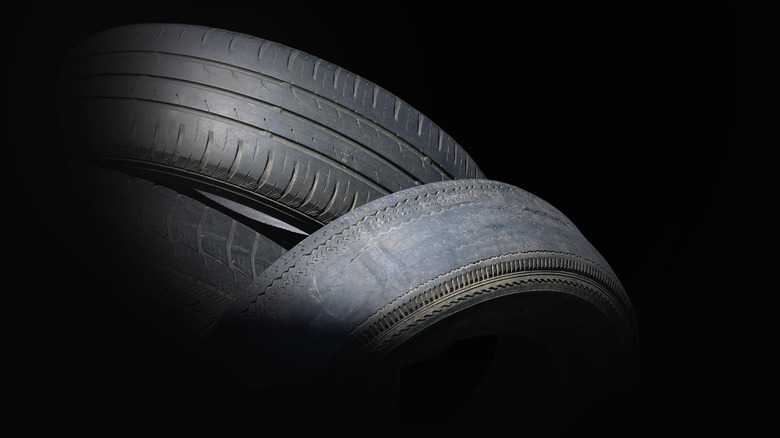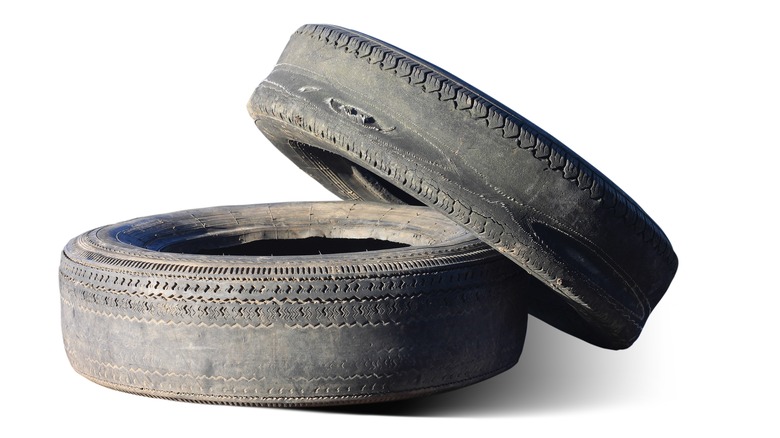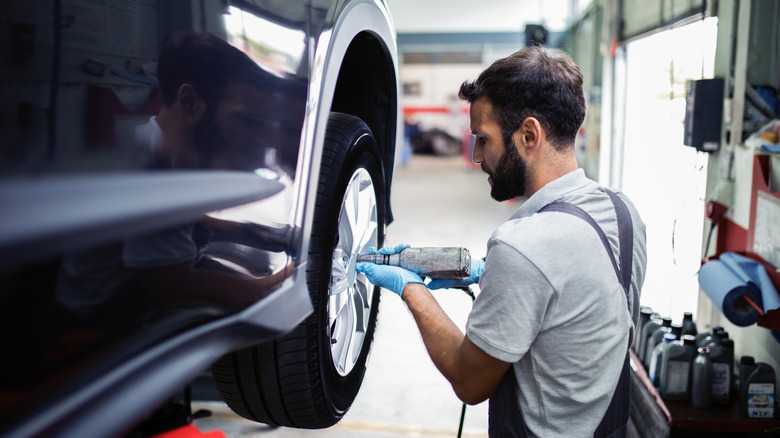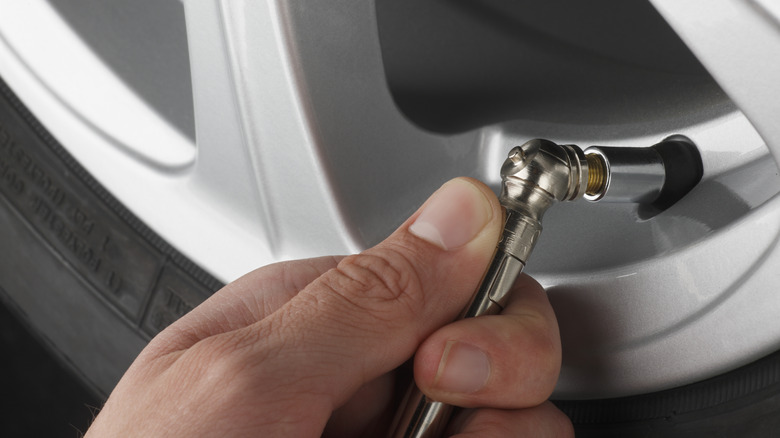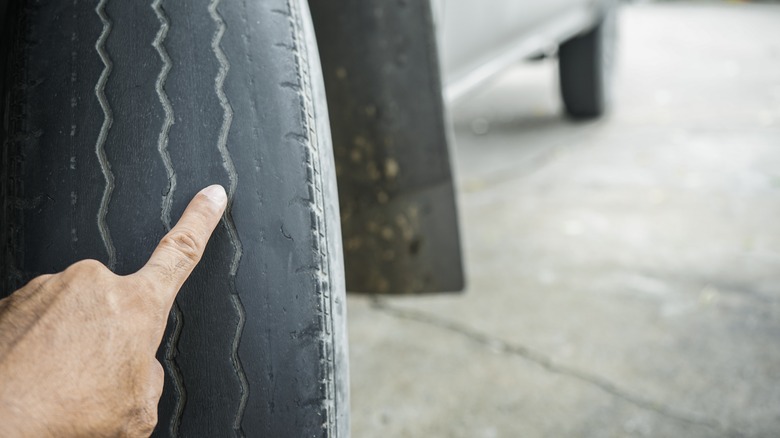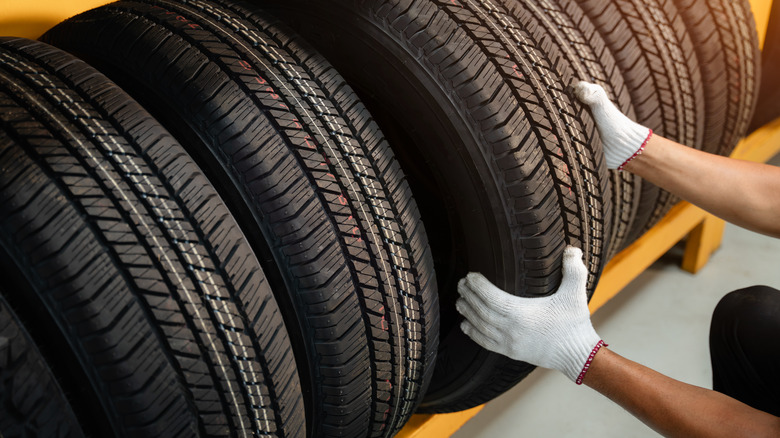Here's Why Your Car's Tires Are Wearing Unevenly
Wheels have been around since the beginning of human history. Since the earliest recorded wheel in 3500 B.C., it has come a long way from being made of stone, leather, and metal. Through the years, we've collectively used wheels for machines of every kind, especially for transportation. Initially, these wheels were met with a lot of durability issues, especially with exposure to the elements and impact on the less developed roads.
In 1839, Charles Goodyear was said to have developed the practice of vulcanization, wherein rubber is heated with sulfur to form commercially usable rubber. Rubber wheels could sustain not only damage but also good shock absorption capabilities. Six years later, Robert Thompson created the first air-filled tire called the "Aerial Wheel." Hemmings shares how it used a rubberized fabric tube filled with pressurized air encased in a thick leather outer skin. It was developed for carriages at the time because bicycles had not yet been widely adopted. Although it was believed to be a commercial failure, it did create the foundations for what we now know to be the modern tire.
In 1887, John Boyd Dunlop developed the pneumatic tire that could be used by all vehicles, which was met with commercial success. Since then, the tire has evolved to meet the growing demands of an evolving society. However, one key problem still exists: wear and tear. For over a century, uneven wear in tires has been a problem we've been trying to overcome.
Why you should care about uneven tire wear
The National Highway Traffic Safety Administration (NHTSA PDF) claims that tire-related issues cause approximately 11,000 crashes and 200 casualties annually in the United States alone. In 2012, Consumer Reports shared an NHTSA study, which found that 5% of all vehicles studied experienced tire problems immediately before a crash. Using crash data from 2005 to 2007, before the advent of mandatory tire pressure monitoring systems, it revealed that 66% of crashes were composed of passenger cars.
Unfortunately, many of these could have been prevented with the right maintenance. By keeping the correct tire pressure, you'll give your car better weight distribution, avoid blowouts, reduce rolling resistance, and keep your tire wear more even. Not to mention, considering how you could potentially spend $50 to over $1,000 for a single new tire, you can benefit from keeping it working for longer.
Depending on the root cause, you'll be able to notice uneven tire wear on different areas of your tire, whether it's the sides or the center. In addition, the type of wear, such as if it is patchy or appears to have diagonal scalloping, also reveals other potential problems with your vehicle. Although tire wear is part and parcel of the car owner's experience, uneven tire wear can be avoided. Here are a few reasons why your car tires may be wearing unevenly and how to spot them.
Poor tire alignment
Aside from improved fuel efficiency and safety, keeping your tires from wearing out is among the many reasons tire alignment is important. Caution: Poor alignment could lead to several tire wear issues, such as excessive tire wear on your tire's inner or outer edges. Sometimes called "toe wear," this type of tire wear happens when one side of the tread block wears faster in a circumferential manner.
Aside from this, Bridgestone also mentions that an excessive toe and caster could also lead to "feathering," or when the tread ribs are worn smoother on one side and sharper on the other. Lastly, it mentions how one-sided shoulder tire wire could also occur, wherein the inside or outside shoulder ribs are significantly more worn out than the other.
If you suspect that poor alignment is the cause of your uneven tire issues, there are other signs that you can look out for, such as your car veering to one side, the steering wheel feeling loose, or the steering wheel not in the center position when driving straight.
It's recommended that you get your wheels aligned every two to three years. However, you can do this more often, especially if your lifestyle entails a lot of off-road activities or you've recently experienced an accident.
Tire pressure issues
Have you ever noticed that the center of your tires is wearing out faster than the sides or bulging out? It's likely due to tire pressure issues. In hopes of reducing tire-related casualties, the United States passed the Transportation Recall Enhancement, Accountability, and Documentation (TREAD) Act, which required car makers to equip their cars with tire pressure monitoring systems (TPMS) in 2007. For example, when your tire pressure falls below 25% of the recommended PSI, many cars will show a red light on their dashboard. However, even before it reaches this level, under or over-inflation can still cause some issues with your vehicle, including uneven tire wear.
To make sure that your tires are properly inflated, you'll first need to know the recommended tire pressure for your particular vehicle. To do this, you can either check your car's owner's manual or a sticker found on your car. Although, most tires require between 28 and 36 PSI.
It's possible to lose or gain 1 pound per square inch (PSI) for every 10 degrees of change in temperature because tires naturally deflate over time. Your tires can also gradually lose pressure, so getting them checked once a month is recommended to be sure.
When checking your tire pressure, you should give your car time to cool down to get a more optimal reading. To get proper measurements, it's best to check tire pressure first thing in the morning or wait at least three hours after driving.
Worn out suspension
Because tires are the only part of your vehicle to touch the road, they play a crucial part in making sure you don't start rolling over when you start to hit the pedal. However, another part of the car that you should thank? Your suspension.
Working in tandem with your tires, the suspension allows you to control your car and maintain contact with the road. Made of springs, shock absorbers, and joints, suspensions help ensure that your car can withstand everything from everyday traffic to more intense out-of-town drives. In the past, some car owners even used hydraulic suspension systems to make their cars hop to the beat. These days, newer suspension models have arrived, which can even let some cars "jump."
Typically, a diagonal scalloping pattern or "cupping wear" in your tires can be attributed to suspension issues. Aside from this, squeaking sounds or thudding noises could also be symptoms of suspension damage. If you suspect your car is experiencing suspension problems, you should call a mechanic immediately to avoid issues.
Keep your tires healthy
If you're not entirely sure what's wrong with your tires, it's best to consult with a professional mechanic or two for a second opinion. In some cases, the problem may not even be you, or the way you use your cars, especially with existing tire recalls. To check if your car's tires are included in the list of recalled tires, you can check the National Highway Traffic Safety Administration's (NHTSA) recall website or download the SaferCar app for alerts. The SaferCar app is available for free on iOS and Android.
If you suspect that your new tires have issues straight from the manufacturer, you can also file a report with the NHTSA as well. Once multiple people send similar reports of the same tire, they will be notified and conduct an investigation.
Additionally, there may be some instances wherein you may be better off simply replacing your tires altogether. If you notice any crucial warning signs, such as baldness, revealing tire cords, or bulging, it may not be worth the risk to keep them on your vehicle.
After all, tires affect not only riding comfort and fuel efficiency but also the overall safety of your car. When a tire fails, it can lead to disastrous consequences, especially when it comes to blowouts.
